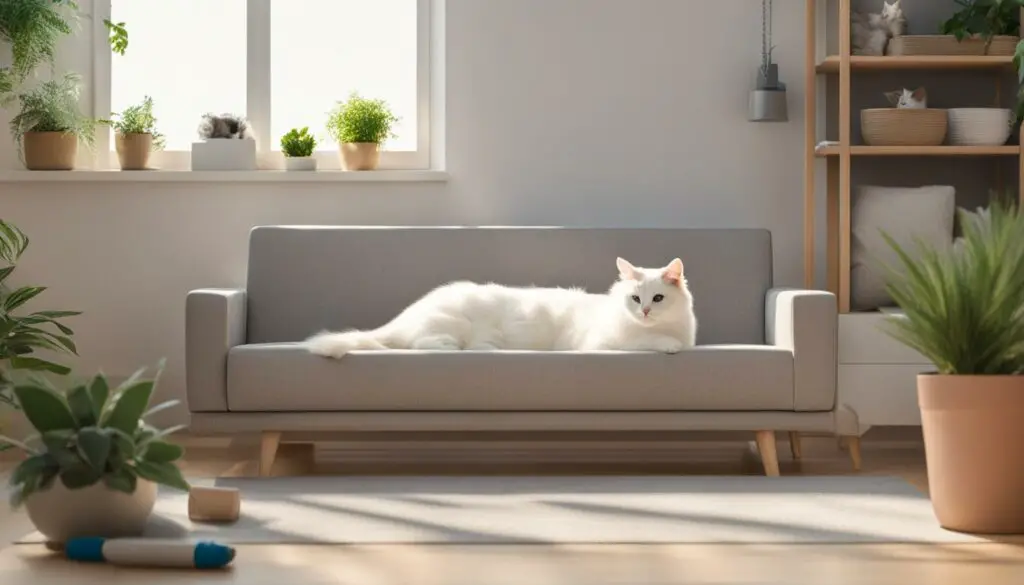Keeping a clean house with cats can be a challenge, but with these easy and effective cat-friendly cleaning tips, you’ll be able to maintain a neat and tidy home. From tackling cat hair buildup to eliminating pet odors, I’ll provide you with all the strategies you need to keep your house clean while still enjoying the company of your feline friends.
Key Takeaways:
- Regularly vacuum carpets, furniture, and pet areas to remove cat hair.
- Use a steam cleaner to eliminate parasites and their eggs.
- Mop hard floors with disinfectant to keep them clean and sanitary.
- Wipe down surfaces with pet-safe disinfectant to prevent bacteria or germs.
- Properly dispose of cat waste to prevent the spread of parasites or bacteria.
Separating and Treating Infected Cats to Prevent Spread of Worms
When it comes to dealing with a cat that has worms, taking immediate action is crucial. Not only is it important to treat the infected cat, but also to prevent the spread of worms to other pets in your household. By following these simple steps, you can effectively separate and treat the infected cat, ensuring the health and well-being of all your furry friends.
Isolation and Vet Visit
The first step is to isolate the infected cat from other pets to prevent the transmission of worms. Set up a separate living area for the infected cat that includes its own litter box, bedding, and food bowls. This will help minimize the risk of spreading the parasites.
Next, schedule a visit to the vet for a proper diagnosis and treatment plan. The vet will perform tests to identify the type of worms present and prescribe the appropriate deworming medication. It’s crucial to follow the vet’s advice and administer the medication as instructed to effectively eliminate the worms from your cat’s system.
Preventative Measures
While treating the infected cat, it’s important to take preventative measures to avoid further worm infestations. Clean and disinfect the living area regularly, focusing on areas where your cat spends the most time. Wash bedding, litter boxes, and toys in hot water with detergent to kill any remaining parasites. Use a pet-safe disinfectant to wipe down surfaces and eliminate any potential bacteria or germs.
Regular Vet Check-ups
After treatment, it’s crucial to schedule regular check-ups with the vet to monitor your cat’s health and prevent future infections. The vet will recommend a deworming schedule based on your cat’s lifestyle and potential exposure to parasites. By staying proactive and maintaining a clean and hygienic environment, you can keep your cats healthy and prevent the spread of worms.
By implementing these strategies, you can effectively separate and treat infected cats, preventing the spread of worms to other pets in your household. Remember to always consult with a veterinarian for proper diagnosis and treatment, and to follow a regular deworming schedule to keep your cats healthy and happy.
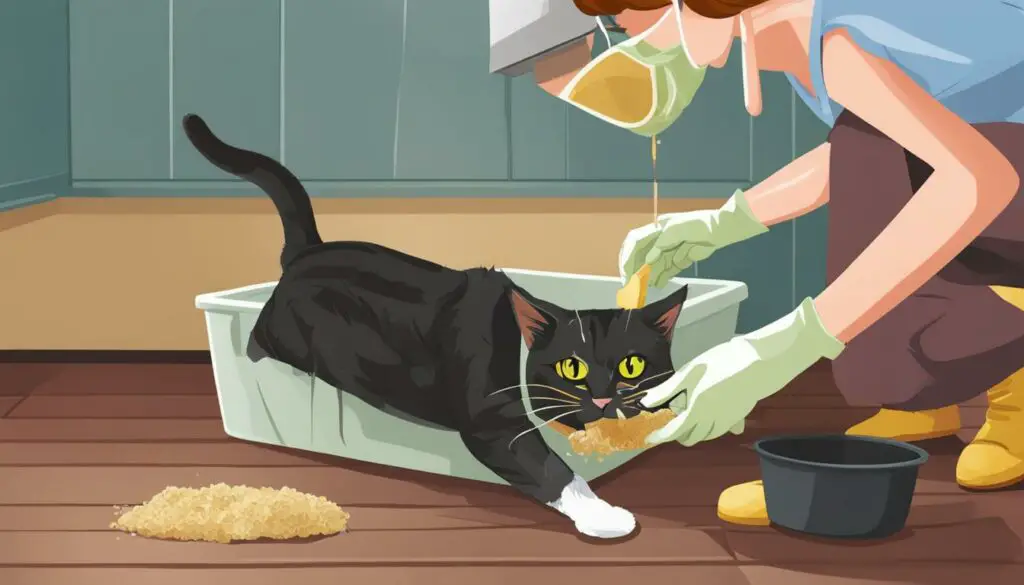
Cat-Friendly Cleaning Tips: Protecting Yourself When Cleaning
When it comes to keeping your house clean with cats, it’s important to not only think about the well-being of your furry friends but also prioritize your own health. Before you start the cleaning process, take precautions by wearing protective gear such as rubber gloves and a face mask. These simple steps can help minimize direct contact with potentially infectious materials and safeguard you from harmful bacteria or parasites that may be present in your cat’s bedding or living areas.
Wearing Protective Gear Before Cleaning
In order to protect yourself when cleaning, it is recommended to:
- Wear rubber gloves to prevent direct contact with potentially harmful substances.
- Use a face mask to reduce the inhalation of dust, dander, or other allergens that may be present in the cleaning process.
By taking these preventive measures, you can ensure that your cleaning routine remains safe and cat-friendly.
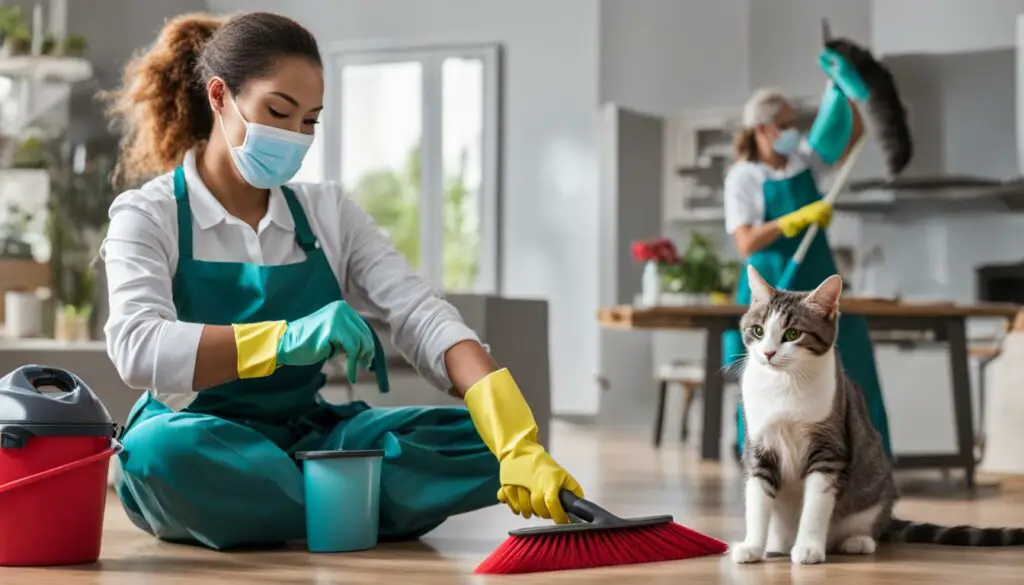
Quote: “Taking the necessary precautions to protect yourself while cleaning is crucial for maintaining a clean and safe home environment for both you and your feline companions.” – Anonymous
Table: Recommended Protective Gear
| Gear | Usage |
|---|---|
| Rubber Gloves | Prevent direct contact with potentially harmful substances |
| Face Mask | Reduce inhalation of dust, dander, or other allergens |
By following these cat-friendly cleaning tips and wearing the appropriate protective gear, you can ensure a safe and hygienic environment for both yourself and your beloved feline companions.
Cat-Friendly Cleaning Supplies: Essential Tools for Cat Owners
When it comes to keeping your house clean with cats, having the right cleaning supplies on hand is essential. Whether you’re tackling pet hair, eliminating odors, or disinfecting surfaces, having cat-friendly cleaning supplies will make the task easier and more effective. Here are some essential tools every cat owner should have:
Cleaning Supplies
- Steam cleaner: A steam cleaner is a versatile tool that can be used to clean carpets, upholstery, and other surfaces. It provides a deep clean without the need for harsh chemicals.
- Disinfectant cleaner: Look for a pet-safe disinfectant cleaner that can effectively kill bacteria and germs without posing a risk to your cats.
- Hot water and bucket: Hot water is an excellent natural cleaner and can be used in combination with disinfectant cleaners for added effectiveness.
- Cleaning cloths: Having a supply of cleaning cloths will make it easier to wipe down surfaces and clean up messes.
- Bleach solution: In some cases, a bleach solution may be necessary to disinfect certain areas. Ensure it’s diluted properly and used in well-ventilated areas.
- Trash bags: Double-bagging waste materials and disposing of them in outdoor trash bins is important for preventing the spread of parasites and bacteria.
Having these cat-friendly cleaning supplies readily available will save you time and ensure that you can effectively clean and maintain a neat and healthy home environment for both you and your feline friends.
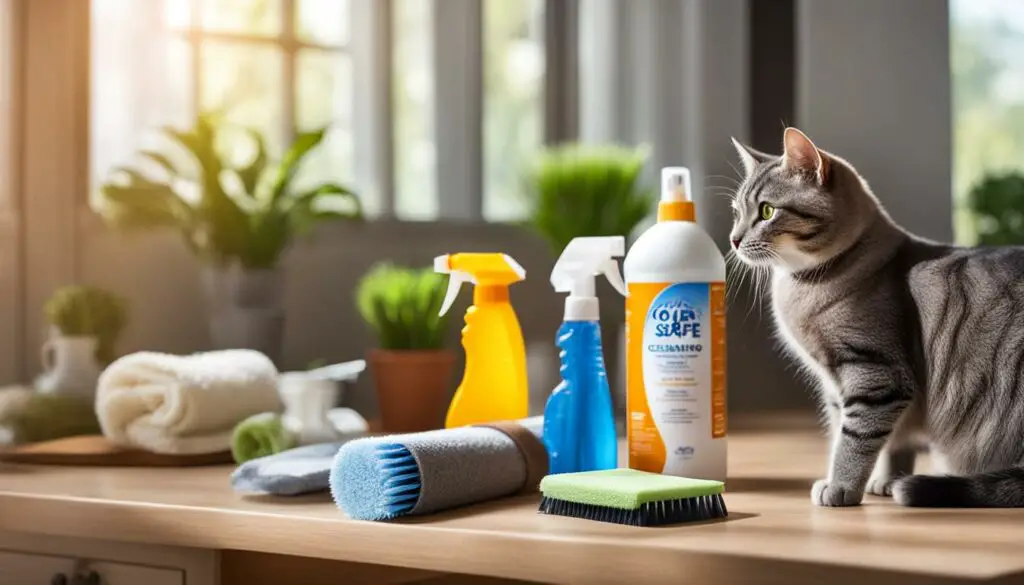
“Having the right cleaning supplies on hand is crucial for maintaining a clean home with cats. With these essential tools, you’ll be well-equipped to tackle any cleaning tasks and keep your house cat-friendly.”
Washing and Disinfecting Cat Bedding
Keeping your cat’s bedding clean is essential to prevent reinfestation and maintain a hygienic environment for your furry friend. By following these simple steps, you can effectively wash and disinfect your cat’s bedding, ensuring a clean and safe resting place.
Gather the Supplies
Before you begin, gather all the necessary supplies you’ll need for washing and disinfecting the cat bedding. This includes laundry detergent, hot water, a washing machine, a dryer, and a pet-safe disinfectant spray or solution.
Wash in Hot Water
Start by washing the bedding in hot water with a pet-friendly laundry detergent. Hot water is effective at killing any parasites or flea eggs that may be present. Make sure to follow the care instructions on the bedding and set the washing machine to the appropriate temperature and cycle.
Dry on High Heat
After washing, transfer the bedding to the dryer and set it on high heat. The heat will help kill any remaining parasites or eggs that may have survived the washing process. Make sure to fully dry the bedding before returning it to your cat’s sleeping area.
Use a Pet-Safe Disinfectant
Once the bedding is dry, you can further disinfect it by using a pet-safe disinfectant spray or solution. Spray or apply the disinfectant according to the product instructions, focusing on areas that your cat frequently comes into contact with. This will help eliminate any remaining bacteria or germs and prevent reinfestation.
| Steps for Washing and Disinfecting Cat Bedding |
|---|
| Gather the necessary supplies: laundry detergent, hot water, washing machine, dryer, and pet-safe disinfectant. |
| Wash the bedding in hot water with a pet-friendly laundry detergent according to the care instructions. |
| Dry the bedding on high heat to ensure all parasites or flea eggs are killed. |
| Use a pet-safe disinfectant spray or solution to further disinfect the bedding. |
By regularly washing and disinfecting your cat’s bedding, you can help prevent reinfestation and create a clean and comfortable space for your pet. Remember to follow the care instructions on the bedding and choose pet-friendly products to ensure the safety of your cat.
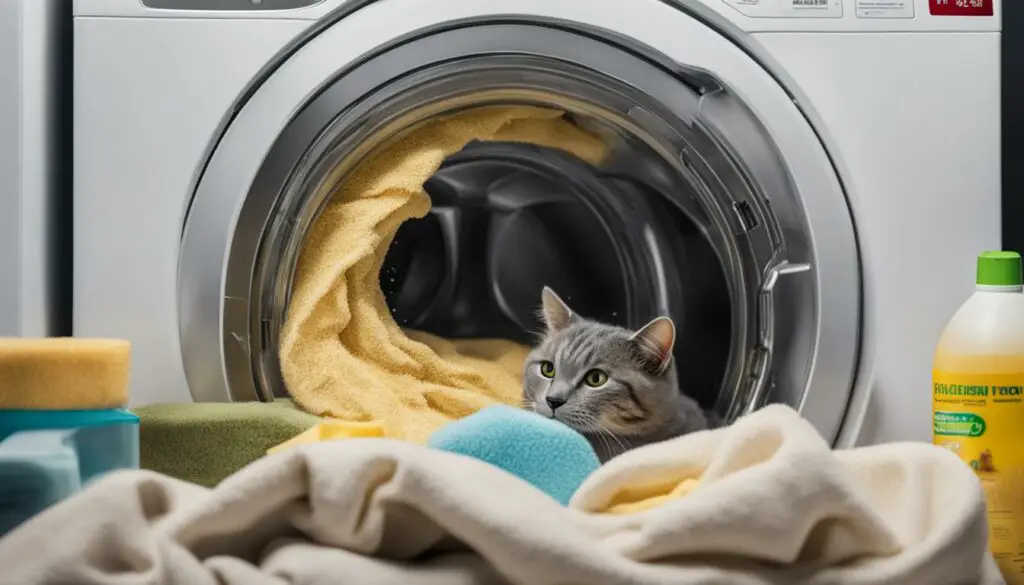
Thoroughly Vacuuming Carpets and Furniture
When it comes to keeping your house clean with cats, one of the biggest challenges is dealing with cat hair. Cats are notorious for shedding, and their fur can quickly accumulate on carpets, rugs, and furniture. To effectively remove cat hair and maintain a clean home, regular and thorough vacuuming is key.
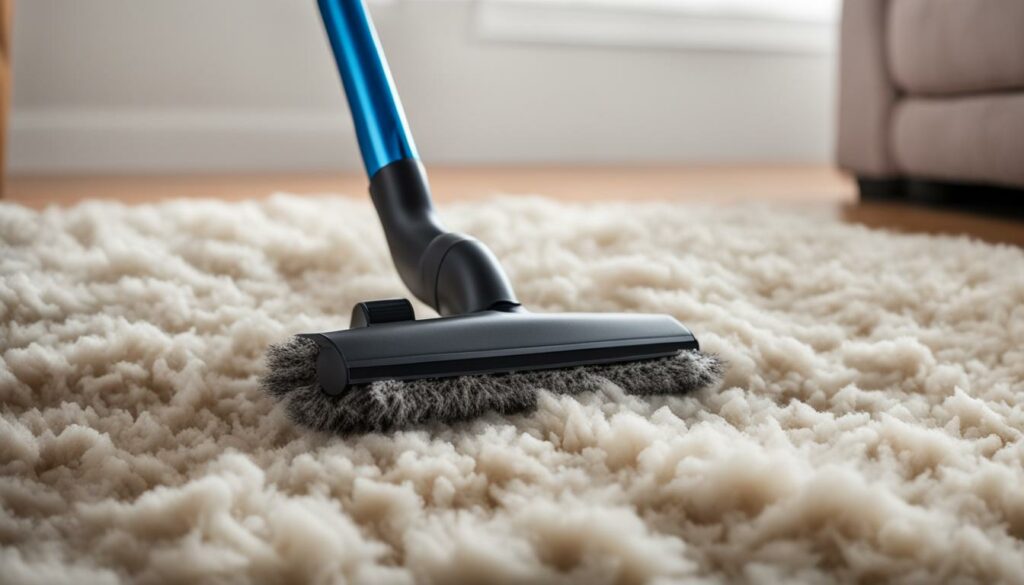
Using a vacuum cleaner with a HEPA filter is highly recommended as it can effectively trap and remove even the tiniest cat hair particles from your carpets and furniture. Make sure to pay special attention to areas where your cats spend most of their time, such as their favorite napping spots or the areas near their scratching posts.
In addition to vacuuming, consider using a lint roller or a pet hair remover brush to tackle stubborn cat hair on upholstery or fabric surfaces. These tools can be especially handy in removing cat hair from curtains, cushions, and other hard-to-reach areas.
Benefits of Thorough Vacuuming
- Removes cat hair and dander that can cause allergies
- Prevents the accumulation of cat hair on carpets and furniture
- Improves indoor air quality by reducing pet allergens
- Maintains a clean and inviting living environment for both cats and humans
Cat-Friendly Cleaning Tips: Sterilizing Surfaces with Steam
When it comes to keeping your home clean and free of harmful bacteria and parasites, steam cleaning is an effective and eco-friendly solution. Using a steam cleaner can provide a thorough sterilization of surfaces without the need for additional chemicals or detergents. Here are some cat-friendly cleaning tips for sterilizing surfaces with steam:
Benefits of Steam Cleaning
- Efficient and Eco-Friendly: Steam cleaning harnesses the power of hot steam to kill germs and bacteria, making it an environmentally friendly cleaning option.
- Chemical-Free: Since steam cleaning only requires water, it eliminates the use of harsh chemicals that can be harmful to your cats and the environment.
- Deep Penetration: Steam can penetrate porous materials, reaching deep into carpets, upholstery, and other surfaces to effectively eliminate bacteria, parasites, and their eggs.
“Steam cleaning is an effective way to kill parasites and their eggs without using harsh chemicals.”
When steam cleaning your carpets and furniture, be sure to follow the manufacturer’s instructions for the specific steam cleaner you are using. Here are some general steps to follow:
- Prepare the steam cleaner by filling it with water according to the manufacturer’s instructions.
- Pre-vacuum the area to remove loose dirt and debris.
- Start steaming the surfaces, working in small sections at a time.
- Move the steam cleaner slowly over the surface, allowing the steam to penetrate and sanitize.
- Pay extra attention to areas where your cats spend most of their time, as these areas may require more thorough cleaning.
- Allow the surfaces to dry completely before allowing your cats back onto them.
By incorporating steam cleaning into your cat-friendly cleaning routine, you can ensure that your home is not only clean but also safe for your feline companions.
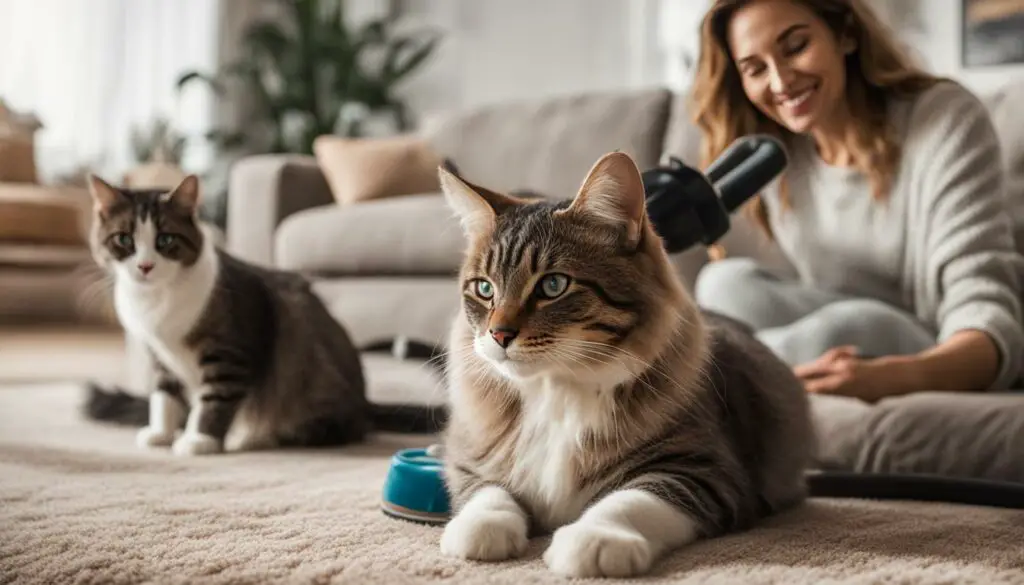
Cleaning Hard Floors with Cat-Friendly Tips
When it comes to cleaning hard floors in your home while ensuring the safety and well-being of your cats, there are a few cat-friendly tips to keep in mind. By following these guidelines, you can effectively maintain a clean and hygienic living environment for both you and your feline companions.
Mop with a Disinfectant Cleaner
To clean hard floors, such as tile, laminate, or hardwood, use a disinfectant cleaner or a bleach solution mixed with hot water. This will not only remove dirt and stains but also eliminate any potential bacteria or germs that may be present.
Start by sweeping or vacuuming the floor to remove loose debris. Then, fill a bucket with the disinfectant cleaner and hot water according to the manufacturer’s instructions. Dip a mop into the solution and wring out any excess liquid. Begin mopping the floor, using gentle but thorough strokes to ensure all areas are covered.
Pay special attention to any areas that may have been soiled by your cats, such as their food or water bowls or areas where they may have had accidents. Make sure to rinse the mop frequently in the cleaning solution to avoid spreading dirt or bacteria from one area to another.
Table 8: Cat-Friendly Tips for Cleaning Hard Floors
| Cleaning Step | Instructions |
|---|---|
| Sweep or vacuum the floor | Remove loose debris and cat hair before mopping. |
| Mix disinfectant cleaner | Follow the manufacturer’s instructions to create the cleaning solution. |
| Mop the floor | Use the disinfectant cleaner or bleach solution and hot water to thoroughly mop all areas. |
| Focus on soiled areas | Pay extra attention to areas that may have been soiled by your cats. |
| Rinse mop frequently | Prevent spreading dirt or bacteria by rinsing the mop in the cleaning solution regularly. |
By regularly mopping your hard floors with a cat-friendly disinfectant cleaner, you can effectively remove dirt, stains, and bacteria while maintaining a clean and healthy home environment. Remember to always use cleaning products that are safe for cats and consult with your veterinarian if you have any concerns about specific cleaning solutions.
Cat-Friendly Cleaning Tips: Disinfecting Surfaces for a Clean and Safe Home
Keeping your home clean and safe for both your cats and your family involves more than just regular cleaning. It also requires proper disinfection of surfaces to eliminate any potential bacteria or germs that may be present. By following these cat-friendly cleaning tips, you can ensure that your home remains clean and your cats stay healthy.
Disinfecting Surfaces: A Step-By-Step Guide
1. Choose a Pet-Safe Disinfectant: Look for disinfectants that are specifically labeled as safe for use around pets. Avoid cleaners that contain harsh chemicals or toxins that can be harmful to your cats.
2. Prepare the Surface: Before disinfecting, remove any visible dirt or debris from the surface. Use a damp cloth or paper towel to wipe away any loose particles. This will ensure that the disinfectant can work effectively.
3. Apply the Disinfectant: Spray or apply the pet-safe disinfectant onto the surface, making sure to cover the entire area. Follow the instructions on the product label regarding the recommended contact time for the disinfectant to work.
4. Let it Sit: Allow the disinfectant to sit on the surface for the recommended amount of time. This will give it enough time to kill any bacteria or germs that may be present. Be patient and avoid wiping or rinsing the surface too soon.
5. Wipe and Rinse: After the recommended contact time has passed, use a clean cloth or paper towel to wipe away the disinfectant from the surface. Rinse the area with clean water if necessary.
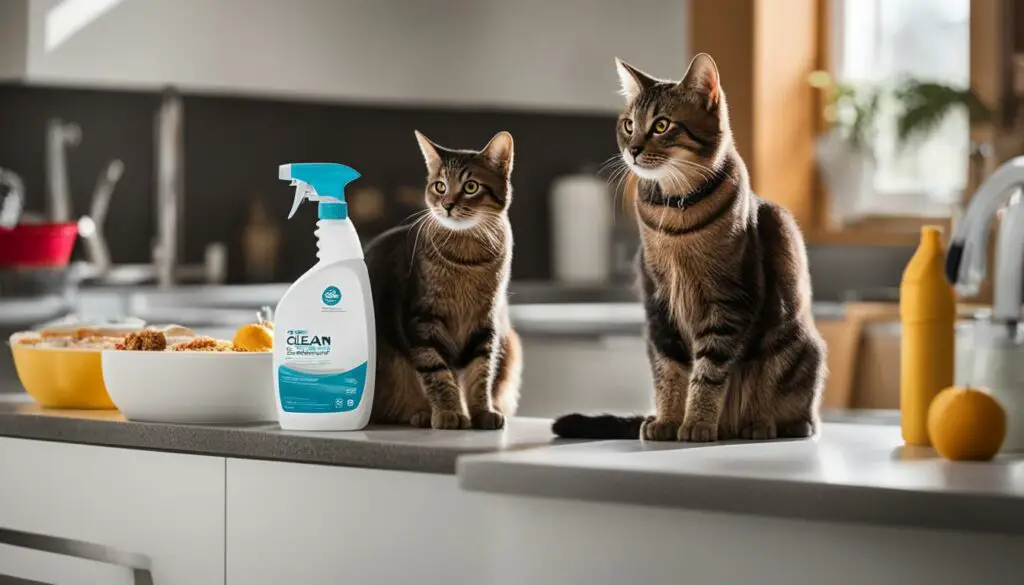
Conclusion
Disinfecting surfaces is an essential part of keeping your home clean and safe for your cats. By following these cat-friendly cleaning tips and using pet-safe disinfectants, you can effectively eliminate bacteria and germs without compromising your cat’s health. Remember to always read and follow the instructions on the product labels, and make disinfection a regular part of your cleaning routine.
Cat-Friendly Cleaning Tips: Proper Waste Disposal
When it comes to keeping a clean and cat-friendly home, proper waste disposal is a crucial aspect. Disposing of cat waste in an appropriate manner not only helps maintain cleanliness but also prevents the spread of potential parasites or bacteria. Here are some cat-friendly cleaning tips for proper waste disposal:
- Double-Bagging and Sealing: It is important to double-bag and seal all waste materials, including cat litter and disposable gloves, before discarding them in an outdoor trash bin. This prevents any potential contamination and ensures that the waste is securely contained.
- Outdoor Trash Bin: Dispose of the double-bagged waste in an outdoor trash bin rather than an indoor trash can. This helps limit any odors or potential germs within your home and keeps the waste away from living spaces.
By following these simple steps, you can effectively dispose of cat waste while maintaining a clean and hygienic environment for both you and your feline companions.
Proper waste disposal is an essential part of cat-friendly cleaning. By double-bagging and sealing cat waste before disposing of it in an outdoor trash bin, you can prevent the spread of parasites or bacteria and maintain a clean home.
Table: Cat-Friendly Waste Disposal Guidelines
| Step | Description |
|---|---|
| Step 1 | Double-bag and seal all waste materials, including cat litter and disposable gloves. |
| Step 2 | Discard the double-bagged waste in an outdoor trash bin. |
Following these waste disposal guidelines will help keep your home clean and free from potential health hazards associated with cat waste. Remember, it’s important to prioritize both cleanliness and the well-being of your furry friends.
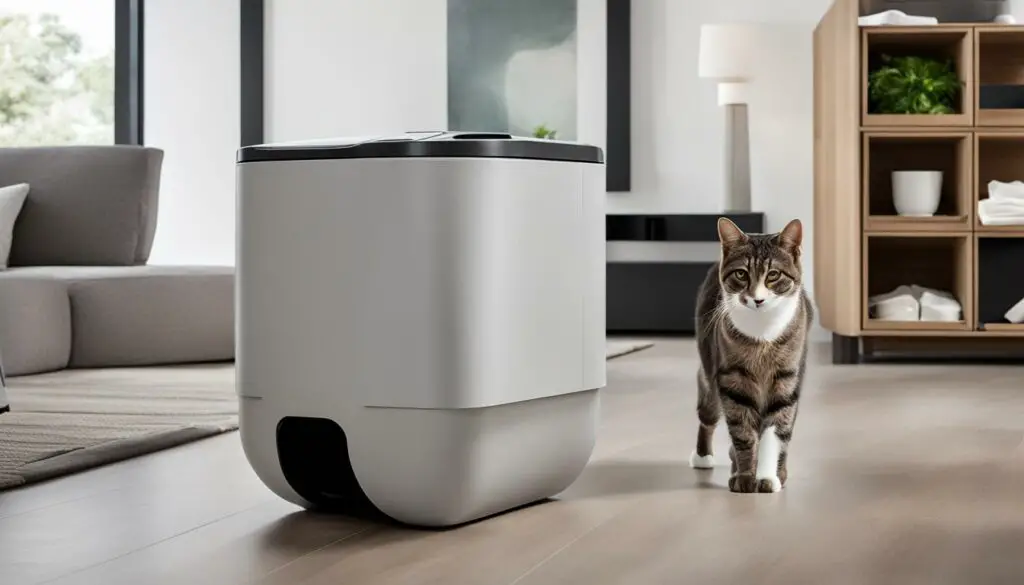
Maintaining a Clean Litter Box
One of the essential aspects of keeping a clean and odor-free home with cats is maintaining a clean litter box. A dirty litter box not only leads to unpleasant odors but can also contribute to health issues in your furry friends. By following a few cat-friendly cleaning tips, you can ensure that your litter box remains fresh, clean, and inviting for your cats.
Regular Scooping and Cleaning
The first step in maintaining a clean litter box is to scoop it daily. Removing feces and clumps from the litter helps minimize the presence of worm eggs and bacteria. Use a litter scoop to remove waste and dispose of it in a properly sealed bag. Additionally, it’s important to thoroughly clean the litter box at least once a week. Empty the litter, wash the box with mild soap and warm water, and dry it thoroughly before adding fresh litter.
Choosing the Right Litter
The type of litter you use can also impact the cleanliness of the litter box. Some cats are sensitive to scented litters, so it’s best to choose unscented options to avoid any potential aversion. Consider using a clumping litter, as it makes scooping easier and helps minimize odors. It’s also essential to maintain the right litter depth in the box. Aim for a depth of around 2-3 inches to provide adequate coverage while still allowing your cats to dig and bury their waste.
Proper Placement
The placement of the litter box is crucial in ensuring your cats’ comfort and encouraging them to use it regularly. Choose a quiet and easily accessible location for the litter box. Avoid placing it near their food and water bowls, as cats prefer to have separate areas for different activities. Additionally, avoid placing the litter box in areas with high foot traffic to provide your cats with privacy and reduce the chances of accidents outside the box.
Conclusion
Maintaining a clean litter box is vital for both the hygiene of your home and the well-being of your cats. By regularly scooping, cleaning, choosing the right litter, and ensuring proper placement, you can create a clean and inviting toilet area for your furry friends. This not only helps prevent cat litter odor but also promotes good litter box habits, ensuring a harmonious living environment for both you and your cats.
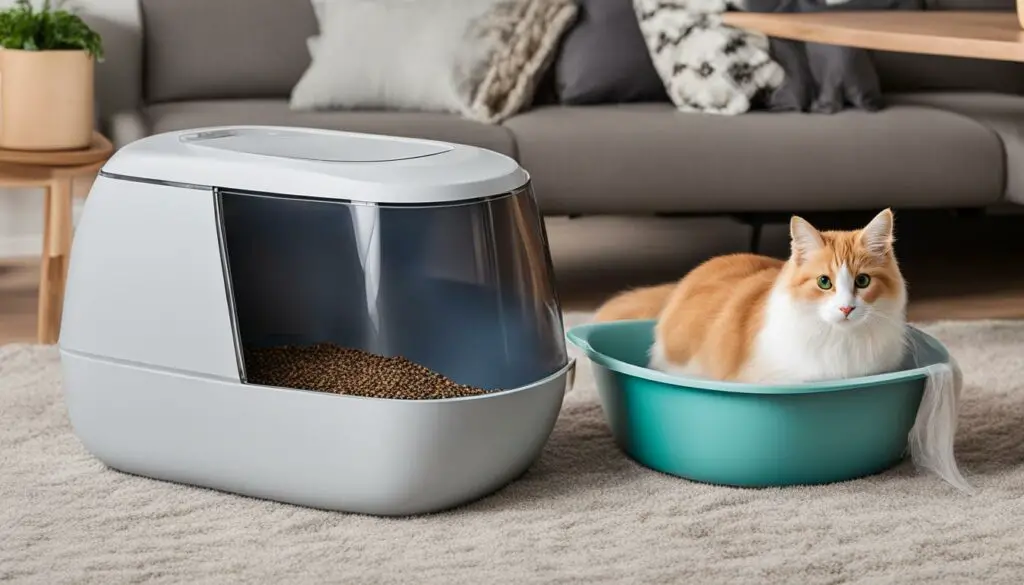
Providing Enrichment for Cats
Cats are natural climbers and scratchers, and providing them with vertical space and scratching posts is crucial for their physical and mental well-being. Giving your cats access to vertical spaces, such as cat condos, shelves, or perches near windows, allows them to satisfy their natural instincts to climb, explore, and observe their surroundings. Not only does this provide them with exercise and mental stimulation, but it also helps prevent them from becoming bored or frustrated, which can lead to destructive behaviors.
Scratching is another important behavior for cats, as it helps them stretch their muscles, mark their territory, and keeps their claws healthy. Providing them with scratching posts or boards in various locations throughout your home will help redirect their scratching behavior away from your furniture. Choose sturdy and tall posts covered in sisal or carpet material, and place them near areas where your cats spend most of their time. Encourage them to use these posts by gently rubbing catnip on them or using interactive toys that can be attached to the posts.
In addition to vertical spaces and scratching posts, it’s important to provide your cats with other forms of enrichment. Interactive and puzzle feeders are a great way to engage your cats during mealtime. These types of feeders require cats to work for their food, stimulating their natural hunting instincts and providing mental stimulation. Start with easy-to-use toys with multiple holes for kibble dispensing, and gradually increase the challenge level as your cats become more proficient.
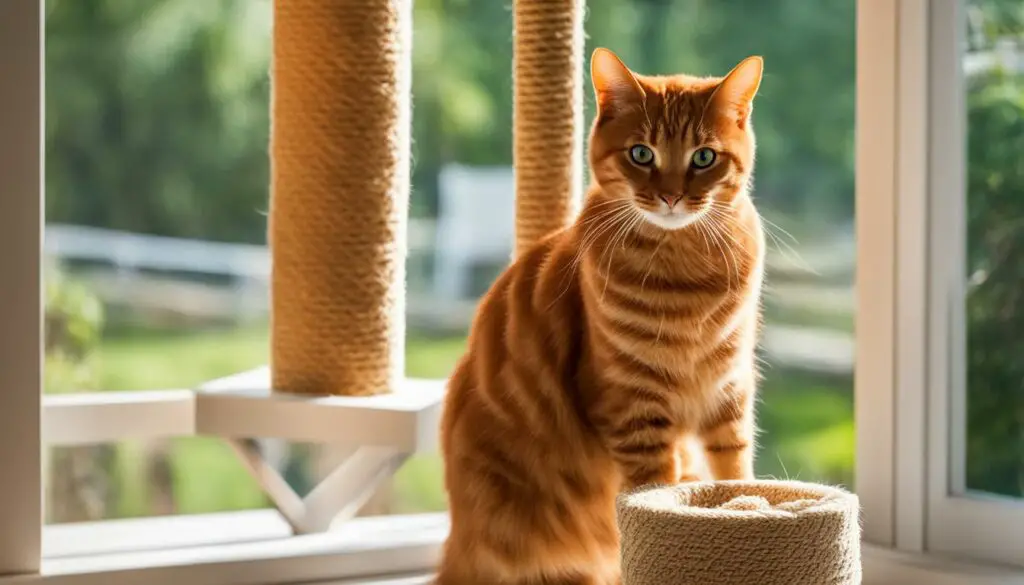
The Benefits of Providing Enrichment for Cats
By providing enrichment for your cats, you are not only satisfying their natural instincts and keeping them mentally and physically stimulated, but you are also preventing unwanted behaviors such as scratching furniture and boredom-related destructive behaviors. Vertical spaces and scratching posts allow cats to claim territory and engage in natural behaviors, while interactive feeders provide mental stimulation and promote healthy eating habits. Overall, providing enrichment for your cats leads to happier, healthier, and well-adjusted feline companions, and creates a harmonious environment in your home.
Using Interactive and Puzzle Feeders
If you’re looking for a fun and engaging way to feed your cats while keeping them entertained, interactive and puzzle feeders are the perfect solution. These innovative feeding tools not only provide mental stimulation for your feline friends but also help prevent overeating and boredom-related behavior. Let’s explore the benefits of using interactive and puzzle feeders and how they can enhance mealtime for your cats.
Benefits of Interactive and Puzzle Feeders
- Stimulates Natural Hunting Instincts: Interactive and puzzle feeders mimic the hunting experience by making cats work for their food. This engages their natural instincts and keeps them mentally and physically active.
- Controls Eating Speed: Many cats tend to eat their food too quickly, which can lead to digestive issues. Interactive and puzzle feeders slow down the eating process, encouraging your cats to eat at a healthier pace.
- Reduces Boredom and Destructive Behavior: Cats can become bored easily, especially when left alone for long periods. Interactive and puzzle feeders provide a stimulating activity that keeps them occupied and helps prevent destructive behavior like scratching furniture or excessive meowing.
When introducing interactive and puzzle feeders to your cats, start with simpler designs and gradually increase the difficulty level as they become more proficient. These feeders come in various shapes and sizes, from treat balls to food-dispensing toys, allowing you to choose the ones that best suit your cats’ preferences. Remember to monitor your cats while they’re using the feeders to ensure they’re not getting frustrated or overwhelmed.
Using interactive and puzzle feeders is a great way to engage your cats during mealtime while providing mental and physical stimulation. It’s important to choose feeders that are safe and appropriate for your cats’ size and age. These feeders can make mealtime a fun and challenging experience for your cats, keeping them entertained and satisfied.
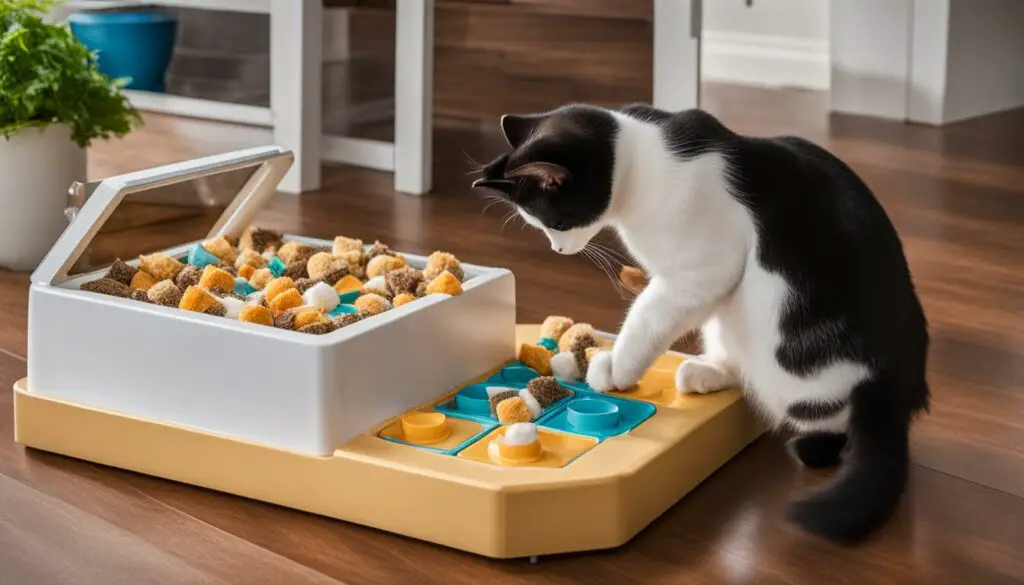
Incorporating interactive and puzzle feeders into your cats’ mealtime routine is a wonderful way to enrich their lives and strengthen the bond between you and your furry friends. Not only will it make mealtime more enjoyable, but it will also provide mental stimulation and prevent boredom-related issues. So why not give it a try and see the positive impact it can have on your cats’ overall well-being?
Cat-Friendly Cleaning Tips: Proper Litter Box Placement and Maintenance
Proper litter box placement and maintenance play a crucial role in keeping your home clean and cat-friendly. By following these tips, you can create a clean and inviting toilet area for your cats while minimizing mess and odors throughout your home.
Choosing the Right Location
The location of the litter box is essential to ensure your cats feel comfortable using it and to prevent accidents. Place litter boxes in quiet, low-traffic areas where your cats can have privacy. Avoid placing them near noisy appliances or in areas where there might be disturbances that could startle your cats. Additionally, avoid placing litter boxes near room perimeters or in areas that may be difficult for your cats to access.
Providing Multiple Options
It’s important to provide multiple litter box options for your cats, especially if you have multiple feline companions. Cats prefer to have options for their toileting needs, so spreading out several litter boxes in different areas of your home can help prevent accidents and encourage proper litter box usage. Each litter box should be easily accessible and have plenty of room for your cats to move comfortably.
Maintaining a Clean Litter Box
Scooping the litter box daily is crucial to keep it clean and odor-free. Remove feces and clumps promptly to minimize the presence of worm eggs and prevent odors from spreading throughout your home. Additionally, deep-clean the litter box every few weeks to remove any residual waste particles and maintain a fresh environment for your cats. Use mild, unscented soap and water to clean the litter box and ensure it is thoroughly dry before adding fresh litter.
| Litter Box Placement Tips | Maintenance |
|---|---|
| Choose quiet, low-traffic areas | Scoop daily to remove feces and clumps |
| Avoid noisy or high-disturbance areas | Deep-clean every few weeks |
| Spread out multiple litter boxes | Use mild, unscented soap and water for cleaning |
| Ensure easy access for your cats | Ensure thorough drying before adding fresh litter |
By implementing proper litter box placement and maintenance practices, you can create a clean and comfortable environment for your cats while keeping your home free from litter box-related mess and odors.
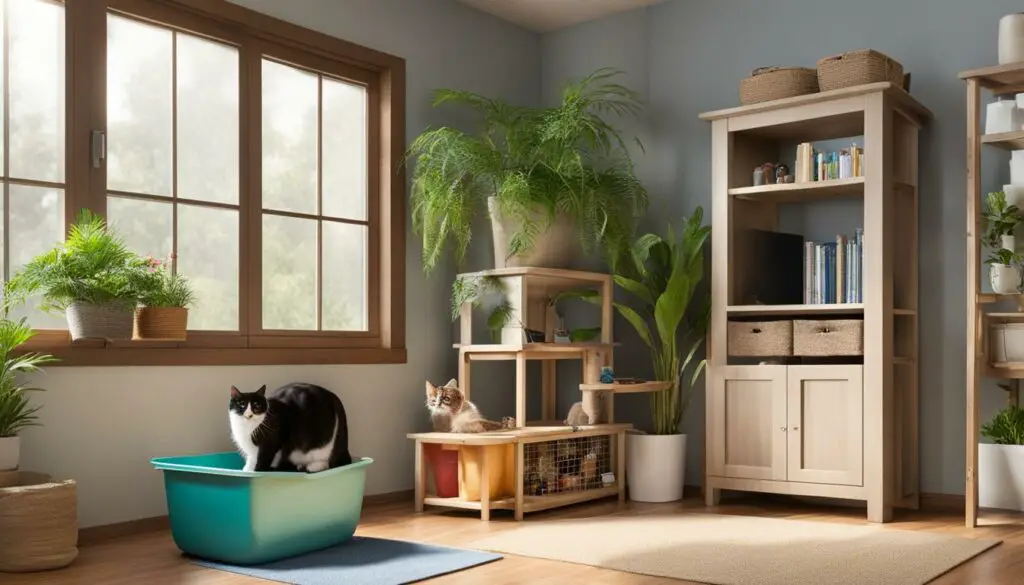
Conclusion
So there you have it, my friend! With these easy and effective cat-friendly cleaning tips, you can maintain a clean and tidy home while enjoying the company of your beloved feline friends. By following these strategies, you’ll be able to keep your house in tip-top shape and provide a safe and healthy environment for both you and your cats. Remember, maintaining a clean home with pets requires consistent effort and prevention.
Regular vet visits, deworming, and proper litter box maintenance are essential steps in keeping your home free from unwanted parasites and odors. Additionally, providing vertical space, scratching posts, and interactive feeders will help fulfill your cats’ natural behaviors and keep them engaged and happy.
So don’t let the challenges of keeping a clean house with cats discourage you. Armed with these cat-friendly cleaning tips, you can create a harmonious living environment where cleanliness and cat companionship go hand in hand. Remember, a clean home equals a happy home for both you and your furry friends!
FAQ
How can I prevent the spread of worms to other pets?
It’s important to isolate and treat the infected cat. Take them to the vet for appropriate treatment, which may include deworming medication. Follow the vet’s advice and take precautionary measures to prevent further infestations.
What protective gear should I wear when cleaning?
It’s important to wear rubber gloves and a face mask to minimize direct contact with potentially infectious materials and protect yourself from harmful bacteria or parasites.
What cleaning supplies do I need?
Gather a steam cleaner, disinfectant cleaner, hot water, bucket, cleaning cloths, bleach solution, and trash bags. Having these supplies on hand will make the cleaning process easier and more efficient.
How should I clean cat bedding?
Wash all cat bedding in hot water with detergent and dry them on high heat to kill any remaining parasites. Use a disinfectant spray to further prevent worm reinfestation.
How do I remove cat hair from carpets and furniture?
Use a vacuum cleaner with a HEPA filter to thoroughly vacuum all carpets, rugs, upholstered furniture, and pet areas. Pay special attention to areas where your cats spend most of their time for effective cat hair removal.
Can I use steam cleaning to sterilize surfaces?
Yes, steam cleaning is an effective way to kill parasites and their eggs without harsh chemicals. Follow the manufacturer’s instructions when using a steam cleaner on carpets, upholstery, and other surfaces.
How should I clean hard floors?
Clean hard floors, such as tile, laminate, or hardwood, with a disinfectant cleaner or bleach solution and hot water. Focus on areas that may have been soiled by your cats and mop regularly for a clean environment.
What should I use to disinfect surfaces?
Wipe down all surfaces with a pet-safe disinfectant, paying special attention to areas frequented by your cats, such as litter boxes, feeding areas, and resting spots.
How should I dispose of waste materials?
Double-bag and seal all waste materials, including cat litter and disposable gloves, before discarding them in an outdoor trash bin to prevent the spread of potential parasites or bacteria.
How do I maintain a clean litter box?
Scoop the litter box daily to remove feces and clumps. Replace the litter and thoroughly clean the litter box at least once a week to prevent odor and provide a clean toilet area for your cats.
How can I provide enrichment for my cats?
Provide cat condos, shelves, perches, and scratching posts near windows for your cats to climb, perch, and scratch. This will fulfill their natural behaviors and prevent damage to furniture.
How can I engage my cats during mealtime?
Use interactive and puzzle feeders that require cats to work for their food, stimulating their natural hunting instincts. Start with easy-to-use toys and gradually increase the challenge level.
Where should I place litter boxes and how often should I clean them?
Place litter boxes in convenient and accessible locations throughout your home. Spread them out to provide multiple options for your cats. Scoop daily and deep-clean every few weeks for a clean and inviting toilet area.
How can I keep my house clean with cats?
By following these easy and effective cat-friendly cleaning tips, you can maintain a clean and tidy home while enjoying the company of your cats.

